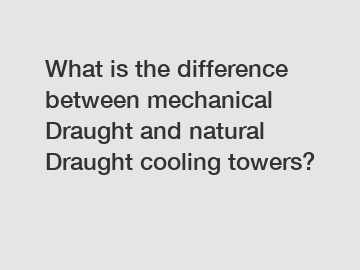Cooling towers are essential components in industrial processes that require the removal of heat from systems. They come in two main types: mechanical Draught and natural Draught cooling towers. While both serve the same purpose of dissipating unwanted heat, there are distinct differences between the two types. Understanding these differences can help industries choose the best cooling tower system for their specific needs.
Mechanical Draught Cooling Towers.
Mechanical Draught cooling towers use fans or blowers to force air through the tower, creating a draft that removes heat from the system. These towers are typically smaller in size and more compact compared to natural Draught cooling towers. They are also more versatile and can be placed in various locations within an industrial facility.

One of the main advantages of mechanical Draught cooling towers is their ability to control the airflow and cooling process more precisely. This control allows for better regulation of temperature and efficiency in heat removal. In addition, mechanical Draught cooling towers can handle higher heat loads and are more suitable for applications that require consistent cooling even in extreme weather conditions.
These cooling towers are also easier to maintain and operate. They can be automated, with control systems that adjust fan speed and water flow based on the cooling requirements of the system. This automation reduces the need for manual intervention and ensures optimal performance at all times.
Natural Draught Cooling Towers.
Natural Draught cooling towers rely on the natural buoyancy of air to create a draft that pulls air through the tower. The design of these towers includes a tall chimney-like structure that utilizes the difference in temperature and pressure to create airflow. Natural Draught towers are typically larger in size compared to mechanical Draught towers and have a distinct hyperbolic shape.
One of the main advantages of natural Draught cooling towers is their energy efficiency. Since they do not require fans or blowers to create airflow, they consume less electricity, making them a cost-effective option for industries looking to reduce energy consumption. Natural Draught towers also have lower maintenance requirements since they have fewer moving parts compared to mechanical Draught towers.
However, natural Draught cooling towers have limited control over the cooling process. They rely on natural forces for airflow, which can be affected by weather conditions such as temperature, wind speed, and humidity. This lack of control can lead to fluctuations in cooling performance, especially during extreme weather conditions.
Choosing the Right Cooling Tower.
The decision to choose between mechanical Draught and natural Draught cooling towers depends on various factors such as the size of the facility, cooling requirements, energy efficiency goals, and budget constraints. Industries should consider these factors carefully before selecting a cooling tower system that best suits their needs.
In conclusion, both mechanical Draught and natural Draught cooling towers have their own set of advantages and limitations. Mechanical Draught towers offer precise control and higher efficiency, while natural Draught towers are more energy-efficient and have lower maintenance requirements. Industries should evaluate their specific requirements and choose the cooling tower system that aligns with their goals and objectives.
If you have any questions or need assistance in selecting the right cooling tower for your industrial facility, please feel free to contact us for expert guidance and support.
If you want to learn more, please visit our website what is cooling tower packing, sprinkler cooling tower, function of drift eliminator in cooling tower.


Comments
Please Join Us to post.
0